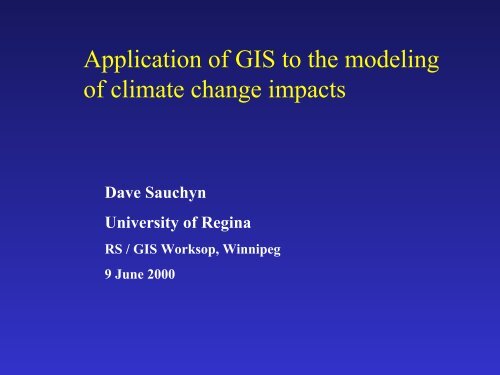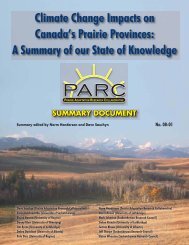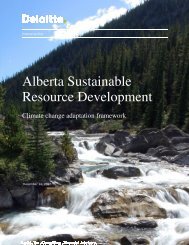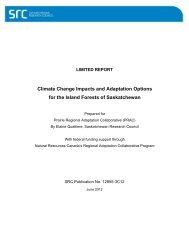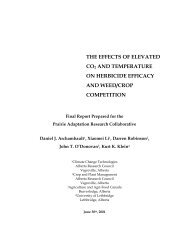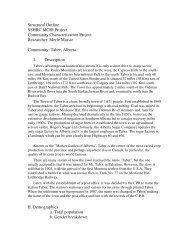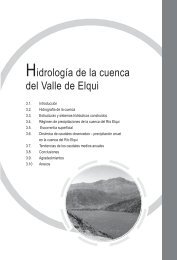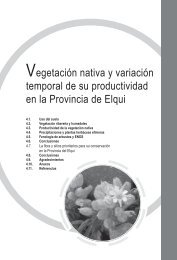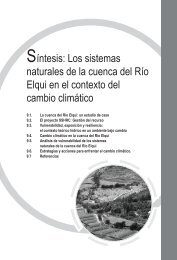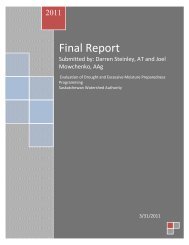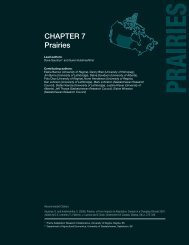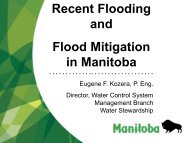Application of GIS to the Modeling of Climate Change Impacts
Application of GIS to the Modeling of Climate Change Impacts
Application of GIS to the Modeling of Climate Change Impacts
You also want an ePaper? Increase the reach of your titles
YUMPU automatically turns print PDFs into web optimized ePapers that Google loves.
<strong>Application</strong> <strong>of</strong> <strong>GIS</strong> <strong>to</strong> <strong>the</strong> modeling<br />
<strong>of</strong> climate change impacts<br />
Dave Sauchyn<br />
University <strong>of</strong> Regina<br />
RS / <strong>GIS</strong> Worksop, Winnipeg<br />
9 June 2000
A triadic hierarchy <strong>of</strong> landscape sensitivity: Some sources and controls <strong>of</strong> disturbance<br />
and resistance<br />
Level Disturbance Resistance<br />
physiographic<br />
divisions<br />
soil landscapes and<br />
small watersheds<br />
slopes and<br />
channels<br />
• climatic change: frequency<br />
and magnitude <strong>of</strong><br />
hydroclimatic events<br />
• tec<strong>to</strong>nism<br />
• intrinsic geomorphic<br />
thresholds in large systems<br />
• climatic variability<br />
• major hydroclimatic events<br />
• coupling <strong>of</strong> systems<br />
• hydroclimatic events<br />
• soil hydraulic conductivity<br />
• local relief and slope<br />
• climatic change: surface and<br />
sub-surface water balances<br />
• ecoclimate and surficial<br />
geology<br />
• geomorphic his<strong>to</strong>ry<br />
• landscape disorder<br />
• land cover<br />
• shear strength <strong>of</strong> surficial<br />
materials<br />
• channel roughness<br />
• slope morphology<br />
• plant cover
Scales <strong>of</strong> geomorphic systems: The triadic hierarchy<br />
Level Function Spatiotemporal characteristics<br />
physiographic divisions boundary conditions cyclic; substitution <strong>of</strong> space for time<br />
soil landscapes and<br />
small watersheds<br />
focal level for<br />
environmental<br />
problems<br />
graded; scaling up from slopes and<br />
channels<br />
slopes and channels process mechanics steady (time independence);<br />
integration <strong>of</strong> events over small areas<br />
and short time spans
Geographic characteristics <strong>of</strong> <strong>the</strong> mixed grass prairie ecoregion<br />
General<br />
• 138,600 km 2 • > 50% <strong>of</strong> Canada’s agricultural land<br />
Ecoclimate<br />
• subhumid <strong>to</strong> semiarid • mixed grass prairie<br />
• high inter-annual climatic<br />
variability<br />
• extreme temperature seasonality<br />
Hydrography<br />
• major rivers are throughflowing • significant snow melt run<strong>of</strong>f<br />
• mostly intermittent streams • large area <strong>of</strong> internal drainage<br />
Geomorphology<br />
• poorly integrated drainage network • underfit streams in glacial meltwater valleys<br />
• glaciated sedimentary basin • weakly linked slopes and channels
Surficial Geology, Wood Mountain Map Sheet<br />
AF<br />
C<br />
CS<br />
DE<br />
GF<br />
GL<br />
LAKE<br />
LL<br />
R<br />
RG<br />
TG<br />
TGL<br />
TS<br />
TSs<br />
TT
Disturbance<br />
• annual s<strong>to</strong>rm<br />
• 10-yr s<strong>to</strong>rm<br />
• soil water s<strong>to</strong>rage<br />
• contributing area<br />
• slope gradient<br />
• local relief<br />
• wind magnitude-frequency
Rainfall erosion potential near Swift Current
Resistance<br />
• land cover<br />
• soil texture<br />
• precipitation/ potential<br />
evapotranspiration<br />
• surficial geology<br />
• bedrock geology<br />
• connectiveness<br />
• landscape position
Population,CDs4&8inSaskatchewanand1&4inAlberta<br />
120000<br />
Rural population<br />
Swift Current & Medicine Hat<br />
80000<br />
40000<br />
0<br />
1901 1911 1921 1931 1941 1951 1961 1971 1981 1991 1996
This large belt <strong>of</strong> country embraces districts,<br />
some <strong>of</strong> which are valuable for <strong>the</strong> purposes <strong>of</strong><br />
<strong>the</strong> agriculturalist, while o<strong>the</strong>rs will for ever be<br />
comparatively useless. ... The least valuable portion<br />
<strong>of</strong> <strong>the</strong> prairie country has an extent <strong>of</strong> about 80,000<br />
square miles, and is that lying along <strong>the</strong> sou<strong>the</strong>rn<br />
branch <strong>of</strong> <strong>the</strong> Saskatchewan, and southward from<br />
<strong>the</strong>nce <strong>to</strong> <strong>the</strong> boundary line, ...<br />
CAPT N . JOHN PALLISER,<br />
London, July 8, 1860
Landscape change safety fac<strong>to</strong>r<br />
magnitude <strong>of</strong> barriers <strong>to</strong> change<br />
magnitude <strong>of</strong> <strong>the</strong> disturbing forces<br />
(Brunsden and Thornes, 1979: 476).
Universal Soil Loss Equation (USLE)<br />
A = RKLSCP<br />
A: average annual soil loss<br />
R: rainfall erosivity<br />
K: soil erodibility<br />
L: slope length<br />
S: slope gradient<br />
C: land cover fac<strong>to</strong>r<br />
P: conservation fac<strong>to</strong>r
Resistance<br />
• land cover<br />
• soil texture<br />
• precipitation/ potential<br />
evapotranspiration<br />
• surficial geology<br />
• bedrock geology<br />
• connectiveness<br />
• landscape position
Brown Soil Zone / Mixed Grass Prairie<br />
• 138,600 km 2<br />
• subhumid <strong>to</strong> semiarid<br />
• glaciated plains<br />
• poorly integrated drainage<br />
• weakly linked slopes and channels<br />
• few permanent streams and lakes<br />
• many internally drained basins<br />
• extreme temperature seasonality<br />
• high inter-annual climatic variability
Census Divisions 1 & 4 in Alberta<br />
and 4 & 8 in Saskatchewan
<strong>Climate</strong> Impact Assessment<br />
• forecasting change <strong>to</strong> natural / human systems<br />
without specific reference <strong>to</strong> location<br />
• evaluating models at point locations and<br />
interpolating among points; spatially discontinuous<br />
• evaluating a model by map unit; spatially<br />
continuous<br />
• spatial modeling <strong>of</strong> individual variables; spatially<br />
continuous and maintains spatial integrity <strong>of</strong> data
<strong>the</strong>re is no desert country<br />
CPR promotional car<strong>to</strong>on, 1896<br />
<strong>the</strong> monumental blunder <strong>of</strong> western settlement<br />
David C. Jones, Empire <strong>of</strong> Dust (1987: 21)
Cummulative Soil Erosion Potential<br />
(Kirkby and Cox,1995)<br />
N 0<br />
r 0<br />
CSEP = 2N r 2 0 0 exp(-h/r ) 0<br />
mean annual rain days<br />
mean rainfall per rain day<br />
h threshold soil water s<strong>to</strong>rage
Old Wives’s Lake / Dirt Hills
I think civilization will be hard pushed for room<br />
when it requires <strong>the</strong> coteau <strong>of</strong> <strong>the</strong> Missouri, at<br />
least for agricultural purposes.<br />
Commissioner G.A. French<br />
North-West Mounted Police<br />
Old Wives Creek, 1874


